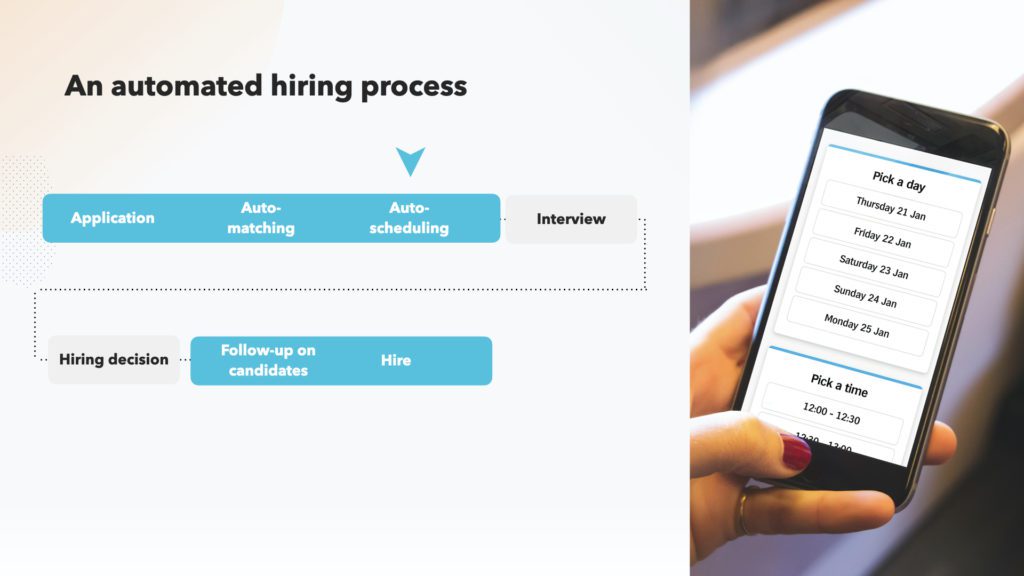How do you handle high-volume hiring in your organization? Volume hiring often forces companies to deal with vast numbers of candidates, multiple locations, managers who must double up as recruiters, and tech stacks that are not suitable to fulfill these demands.
This can lead to a clunky, time-consuming, ineffective hiring process for your recruitment team and candidates, resulting in many challenges, including a poor candidate experience, high employee turnover, unpredictable quality of hire, and increased time to hire.
In the volume hiring space where there are more entry-level roles than suitable candidates, you can’t afford to have your internal hiring process let you down and run the risk of you losing top talent to your competitors. Equally, employees are quitting their jobs at record rates, and a high attrition rate will put a dent in your bottom line.
Following the pandemic, many organizations are looking to expand as economies reopen, but they are increasingly finding that their existing talent acquisition strategies are outdated. With that said, what does an optimum volume hiring process look like, and how can you implement this in your organization today?
What’s in?
Like what you see?
Don’t miss out. Subscribe to our quarterly digest to get the latest TA and TM resources delivered right to your inbox.
6 best practices for high-volume hiring
1. Understand the big picture
The recruitment process for volume hiring requires you to handle large volumes of candidates and data simultaneously. Therefore if you want to design an effective recruiting strategy for both your hiring managers and candidates, you need to understand what this journey looks like for everyone.
What’s your application process like for candidates? Are there any bottlenecks or weak points along the way? What does your employer brand look like to outsiders? What tools and ways of working will make the process most effective for everyone?

By creating a visual representation or map of what your entire volume hiring process looks like, you can spot strengths and limitations and make improvements based on these insights.
At Harver, we sit down with all our clients and help them map out their hiring journey from the get-go so that your recruitment strategy is tailored to your specific needs and goals.
2. Have the end-goal in mind
Begin with your end goal in mind. What are you trying to achieve with your high-volume recruiting strategy?
Is your focus primarily on improving the hiring process for your recruiters, your candidates, or both?
You’ll likely have a few goals in mind, such as increasing process efficiency, reducing time to hire, and therefore attracting higher-quality candidates as a result, which would then lower early attrition and boost your bottom line. Driving profits could be your ultimate goal, in which case you would work backward to determine the steps needed to achieve this through your recruiting efforts.
Harver uses matching technology to help companies hire the right candidates with the right skills and characteristics and also provides an engaging experience for candidates where they learn more about the company and role to help manage their expectations and minimize early attrition.
3. Consider the full hiring journey
Anything that your recruiter does or experiences on the internal side of your hiring process will be felt by your candidates externally. One will always affect the other, and it’s vital that you are mindful of this relationship. Applicants are your customers. Innovative companies drive a recruitment strategy that is candidate-centric.
Processes in the hiring journey generally include an initial application phase, screening, interviews, a job offer, and then onboarding. If a recruiter has to manually move a candidate to the next stage of the process (which is typical in traditional recruitment), your candidate is left waiting longer than they need to be at every stage.
Worse still, if your hiring manager is swimming in other tasks and responsibilities, your candidates will be left waiting even longer, or may not receive a response at all, which can lead to you losing out on the best talent. Therefore, if you want to improve your candidate experience, you must first begin by adjusting the process your recruiters go through to hire.
Harver helps you streamline these processes, which reduces the manual input needed from your recruiters. This makes it easier for candidates to apply and enables you to offer them job security quickly, which is vital in the volume hiring space where job openings are greater than the talent pool.
If you’d like to see how Haver can transform your hiring process,
book a demo here!
4. Consider your data architecture
Before implementing a new tool or adjusting your tech stack, it’s important that you consider your current data architecture. What data do you currently collect? How is it stored, arranged, and integrated with your current system?
In volume hiring, data is your biggest asset. But data is only valuable if you can make sense of what it’s telling you and then take action. Harver offers a self-service analytics suite that collects all your data into one place, making it easy to see the full picture of your recruitment process and pinpoint any weaknesses.
This includes real-time data on matching results, automated decision points, candidate experience, job boards or social media job listings, assessment and interview data, and performance data.

Inside the Harver platform, recruiters can access a series of insight dashboards and recruiting metrics so you can always find the answers you’re searching for.
This includes sourcing insights, bias or D&I insights, and time to action insights. The combination of people science and data science enables organizations to understand key insights and make informed hiring decisions that are fair and objective.
5. Design your candidate experience as part of your employer branding strategy
The experience your candidates have with your hiring process has a direct effect on your employer brand and reputation.
A time-consuming or negative application process might leave candidates questioning how you treat your current employees and also deter unsuccessful candidates from reapplying in the future. Worse still, an unhappy candidate will likely share their negative experience with their immediate network about your poor application process.
Therefore, it’s vital that you build a positive candidate experience with your employer brand in mind. Make your job application short, engaging, and accessible on all devices. Remove the request for a resume and cover letter, which is obsolete with entry-level jobs, and implement pre-employment tests to assess the skills and characteristics linked with top performance in the roles you’re recruiting for.
Instead of relying solely on generic job descriptions, showcase your company culture and offer a realistic job preview to candidates, so they know what they’re walking into. Provide timely feedback, and allow qualified candidates to self-schedule interviews.
A positive candidate experience is likely to improve your quality of hire and increase the number of referrals you receive through your happy job seekers. Within three months of implementing Harver, Arvato found that instead of hiring 45% of interviewed candidates, they now hire 85%.
6. Automate where possible
Technology continues to evolve at a rapid pace, but are you leveraging it in your hiring strategy? The trend we’re witnessing gradually over time is that monotonous human actions are being replaced by technology to speed up the hiring process and save talent teams a lot of time, which they can then channel into more important tasks.
If something in your current talent acquisition strategy doesn’t require real-time human input, why not automate it?
Automation technology can be used for programmatic job advertising, applicant tracking systems, candidate pre-screening, pre-employment assessments, interview scheduling, background checks, and more.
A fully digitized recruitment process can save your team endless hours manually sifting through applications. It also means that if a qualified candidate applies to one of your jobs outside of working hours, they can still progress all the way to scheduling an interview without any manual input needed from your recruiters.

Recruiting automation can lead to increased productivity, improved quality of hire, enhanced candidate experience, bias-free hiring, and a reduced time to hire.
Next steps
Volume hiring differs greatly from traditional recruiting, and therefore demands a different process be used to accommodate the increase of candidates applying for an entry-level role. Thankfully, technology enables you to digitize and automate so many steps of the hiring process and create a seamless, positive experience for both your recruiters and candidates.
If you want to remain ahead in your industry, pay attention to where your ideal candidate spends the most time and the technology they utilize daily. What innovative experiences are they being greeted with by other businesses across different industries? What does a positive hiring process look like to them? The answers to these questions will help you continually improve your volume hiring process and help you hire the best candidates.
If you’d like to see how Harver’s purpose-built volume hiring solution can support you in implementing these best practices, you can book a demo below.
Ready to transform your hiring process?


